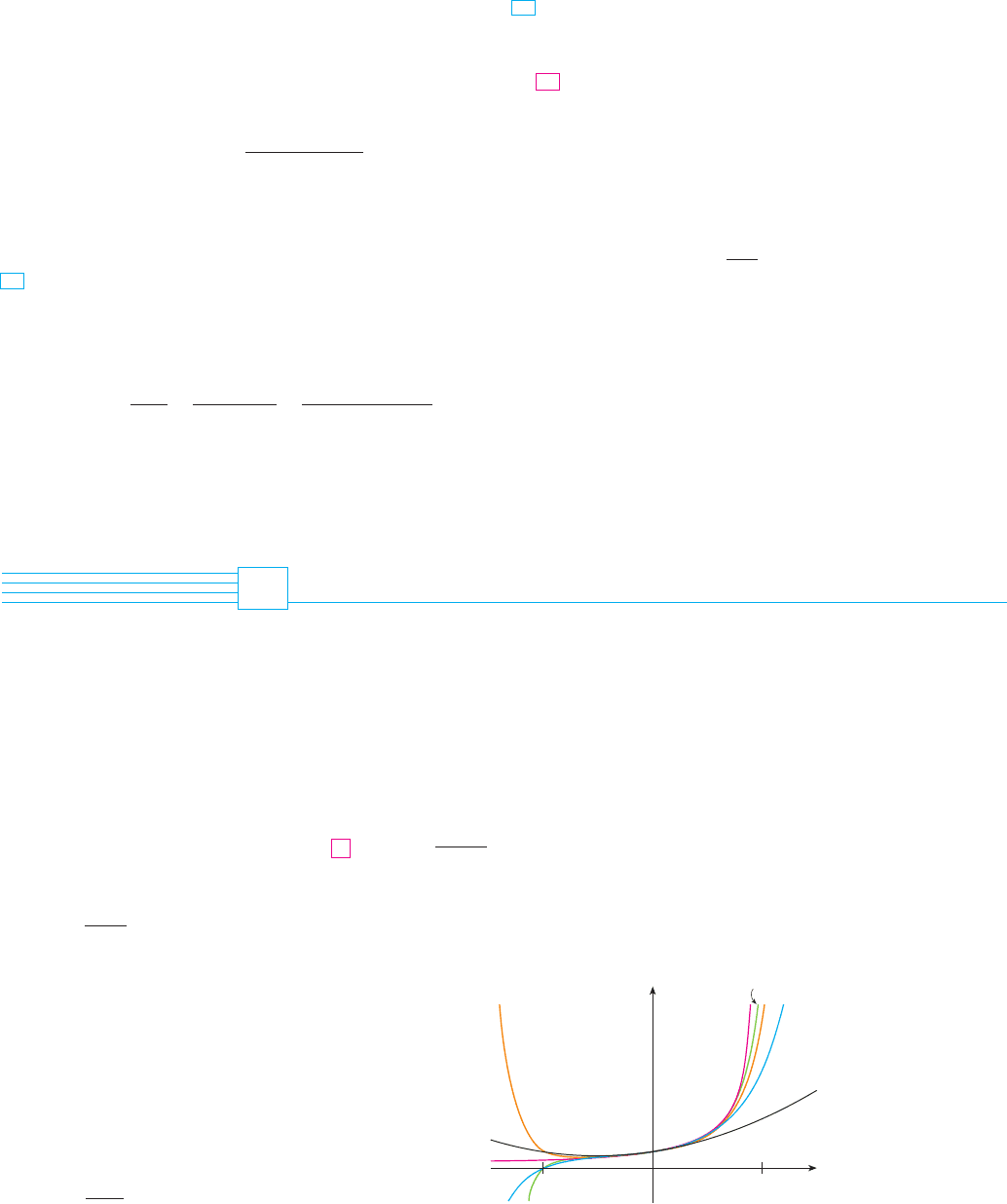Stewart J. Calculus
Подождите немного. Документ загружается.


In general, the Ratio Test (or sometimes the Root Test) should be used to determine the
radius of convergence . The Ratio and Root Tests always fail when is an endpoint of
the interval of convergence, so the endpoints must be checked with some other test.
EXAMPLE 4 Find the radius of convergence and interval of convergence of the series
SOLUTION Let . Then
By the Ratio Test, the given series converges if and diverges if .
Thus it converges if and diverges if . This means that the radius of con-
vergence is .
We know the series converges in the interval , but we must now test for con-
vergence at the endpoints of this interval. If , the series becomes
which diverges.
(
Use the Integral Test or simply observe that it is a -series with
.
)
If , the series is
which converges by the Alternating Series Test. Therefore the given power series con-
verges when , so the interval of convergence is . M
EXAMPLE 5 Find the radius of convergence and interval of convergence of the series
SOLUTION If , then
Using the Ratio Test, we see that the series converges if and it diverges if
. So it converges if and diverges if . Thus the
radius of convergence is .R ! 3
)
x " 2
)
& 3
)
x " 2
)
$
3
)
x " 2
)
'3 & 1
)
x " 2
)
'3
$
1
!
,
1 "
1
n
-
)
x " 2
)
3
l
)
x " 2
)
3
as n l #
$
a
n"1
a
n
$
!
$
!n " 1"!x " 2"
n"1
3
n"2
!
3
n"1
n!x " 2"
n
$
a
n
! n!x " 2"
n
'3
n"1
#
#
n!0
n!x " 2"
n
3
n"1
V
(
!
1
3
,
1
3
]
!
1
3
$
x %
1
3
#
#
n!0
!!3"
n
(
1
3
)
n
s
n " 1
!
#
#
n!0
!!1"
n
s
n " 1
x !
1
3
p !
1
2
$
1
p
#
#
n!0
!!3"
n
(
!
1
3
)
n
s
n " 1
!
#
#
n!0
1
s
n " 1
!
1
s
1
"
1
s
2
"
1
s
3
"
1
s
4
" ( ( (
x ! !
1
3
(
!
1
3
,
1
3
)
R !
1
3
)
x
)
&
1
3
)
x
)
$
1
3
3
)
x
)
& 13
)
x
)
$
1
! 3
.
1 " !1'n"
1 " !2'n"
)
x
)
l 3
)
x
)
as n l #
$
a
n"1
a
n
$
!
$
!!3"
n"1
x
n"1
s
n " 2
!
s
n " 1
!!3"
n
x
n
$
!
$
!3x
.
n " 1
n " 2
$
a
n
! !!3"
n
x
n
'
s
n " 1
#
#
n!0
!!3"
n
x
n
s
n " 1
xR
762
|| ||
CHAPTER 12 INFINITE SEQUENCES AND SERIES

The inequality can be written as , so we test the series at
the endpoints and 1. When , the series is
which diverges by the Test for Divergence [ doesn’t converge to 0]. When ,
the series is
which also diverges by the Test for Divergence. Thus the series converges only when
, so the interval of convergence is .
M
!!5, 1"!5
$
x
$
1
#
#
n!0
n!3"
n
3
n"1
!
1
3
#
#
n!0
n
x ! 1!!1"
n
n
#
#
n!0
n!!3"
n
3
n"1
!
1
3
#
#
n!0
!!1"
n
n
x ! !5!5
!5
$
x
$
1
)
x " 2
)
$
3
SECTION 12.8 POWER SERIES
|| ||
763
25. 26.
27.
28.
If is convergent, does it follow that the following
series are convergent?
(a) (b)
30. Suppose that converges when and diverges
when . What can be said about the convergence or diver-
gence of the following series?
(a) (b)
(c) (d)
31. If is a positive integer, find the radius of convergence of
the series
32. Let and be real numbers with . Find a power series
whose interval of convergence is
(a) (b)
(c) (d)
33. Is it possible to find a power series whose interval of
convergence is ? Explain.%0, #"
%p, q&%p, q"
!p, q&!p, q"
p
$
qqp
#
#
n!0
!n!"
k
!kn"!
x
n
k
#
#
n!0
!!1"
n
c
n
9
n
#
#
n!0
c
n
!!3"
n
#
#
n!0
c
n
8
n
#
#
n!0
c
n
x ! 6
x ! !4
(
#
n!0
c
n
x
n
#
#
n!0
c
n
!!4"
n
#
#
n!0
c
n
!!2"
n
c
n
4
n
(
#
n!0
29.
#
#
n!1
n!x
n
1 ! 3 ! 5 ! ( ( ( ! !2n ! 1"
#
#
n!1
x
n
1 ! 3 ! 5 ! ( ( ( ! !2n ! 1"
#
#
n!2
x
2n
n!ln n"
2
#
#
n!1
!4x " 1"
n
n
2
#
#
n!1
n
2
x
n
2 ! 4 ! 6 ! ( ( ( ! !2n"
24.
#
#
n!1
n!!2x ! 1"
n
23.
1. What is a power series?
2. (a) What is the radius of convergence of a power series?
How do you find it?
(b) What is the interval of convergence of a power series?
How do you find it?
3–28 Find the radius of convergence and interval of convergence
of the series.
4.
5. 6.
8.
9. 10.
11. 12.
13. 14.
16.
17. 18.
19. 20.
21.
, 22.
#
#
n!1
n!x ! 4"
n
n
3
" 1
b & 0
#
#
n!1
n
b
n
!x ! a"
n
#
#
n!1
!3x ! 2"
n
n 3
n
#
#
n!1
!x ! 2"
n
n
n
#
#
n!1
n
4
n
!x " 1"
n
#
#
n!1
3
n
!x " 4"
n
s
n
#
#
n!0
!!1"
n
!x ! 3"
n
2n " 1
#
#
n!0
!x ! 2"
n
n
2
" 1
15.
#
#
n!0
!!1"
n
x
2n
!2n"!
#
#
n!2
!!1"
n
x
n
4
n
ln n
#
#
n!1
x
n
5
n
n
5
#
#
n!1
!!2"
n
x
n
s
4
n
#
#
n!1
10
n
x
n
n
3
#
#
n!1
!!1"
n
n
2
x
n
2
n
#
#
n!1
n
n
x
n
#
#
n!0
x
n
n!
7.
#
#
n!1
s
n
x
n
#
#
n!1
!!1"
n!1
x
n
n
3
#
#
n!0
!!1"
n
x
n
n " 1
#
#
n!1
x
n
s
n
3.
E X E R C I S E S
12.8

(c) If your CAS has built-in Airy functions, graph on the
same screen as the partial sums in part (b) and observe
how the partial sums approximate .
A function is defined by
that is, its coefficients are and for all .
Find the interval of convergence of the series and find an
explicit formula for .
38. If , where for all , find the
interval of convergence of the series and a formula for .
39. Show that if , where , then the radius
of convergence of the power series is .
40. Suppose that the power series
satisfies
for all . Show that if exists, then it is equal
to the radius of convergence of the power series.
41. Suppose the series has radius of convergence 2 and the
series has radius of convergence 3. What is the radius
of convergence of the series ?
42. Suppose that the radius of convergence of the power series
is . What is the radius of convergence of the power
series ?
(
c
n
x
2n
R
(
c
n
x
n
(
!c
n
" d
n
"x
n
(
d
n
x
n
(
c
n
x
n
lim
n l #
)
c
n
'c
n"1
)
n
c
n
" 0
(
c
n
!x ! a"
n
R ! 1'c
(
c
n
x
n
c " 0lim
n l #
s
n
)
c
n
)
! c
f !x"
n ) 0c
n"4
! c
n
f !x" !
(
#
n!0
c
n
x
n
f !x"
n ) 0c
2n"1
! 2c
2n
! 1
f !x" ! 1 " 2x " x
2
" 2x
3
" x
4
" ( ( (
f
37.
A
A
CAS
;
34. Graph the first several partial sums of the series ,
together with the sum function , on a com-
mon screen. On what interval do these partial sums appear to
be converging to ?
35. The function defined by
is called the Bessel function of order 1.
(a) Find its domain.
;
(b) Graph the first several partial sums on a common
screen.
(c) If your CAS has built-in Bessel functions, graph on the
same screen as the partial sums in part (b) and observe
how the partial sums approximate .
36. The function defined by
is called the Airy function after the English mathematician
and astronomer Sir George Airy (1801–1892).
(a) Find the domain of the Airy function.
;
(b) Graph the first several partial sums on a common screen.
A!x" ! 1 "
x
3
2 ( 3
"
x
6
2 ( 3 ( 5 ( 6
"
x
9
2 ( 3 ( 5 ( 6 ( 8 ( 9
" ( ( (
A
J
1
J
1
CAS
J
1
!x" !
#
#
n!0
!!1"
n
x
2n"1
n!!n " 1"!2
2n"1
J
1
f !x"
f !x" ! 1'!1 ! x"
(
#
n!0
x
n
s
n
!x"
764
|| ||
CHAPTER 12 INFINITE SEQUENCES AND SERIES
REPRESENTATIONS OF FUNCTIONS AS POWER SERIES
In this section we learn how to represent certain types of functions as sums of power series
by manipulating geometric series or by differentiating or integrating such a series. You might
wonder why we would ever want to express a known function as a sum of infinitely many
terms. We will see later that this strategy is useful for integrating functions that don’t have
elementary antiderivatives, for solving differential equations, and for approximating func-
tions by polynomials. (Scientists do this to simplify the expressions they deal with; com-
puter scientists do this to represent functions on calculators and computers.)
We start with an equation that we have seen before:
We first encountered this equation in Example 5 in Section 12.2, where we obtained it by
observing that it is a geometric series with and . But here our point of view is
different. We now regard Equation 1 as expressing the function as a sum
of a power series.
F I G U R E 1
ƒ=
1
1-x
and some partial sums
0
x
y
1_1
f
s™
s∞
sˆ
s¡¡
f !x" ! 1'!1 ! x"
r ! xa ! 1
)
x
)
$
1
1
1 ! x
! 1 " x " x
2
" x
3
" ( ( ( !
#
#
n!0
x
n
1
12.9
N A geometric illustration of Equation 1 is
shown in Figure 1. Because the sum of a series
is the limit of the sequence of partial sums, we
have
where
is the th partial sum. Notice that as
increases, becomes a better approxima-
tion to for .
!1
$
x
$
1
f !x"
s
n
!x"
nn
s
n
!x" ! 1 " x " x
2
" ( ( ( " x
n
1
1 ! x
! lim
n l #
s
n
!x"

EXAMPLE 1
Express as the sum of a power series and find the interval of
convergence.
SOLUTION
Replacing by in Equation 1, we have
Because this is a geometric series, it converges when , that is, , or
. Therefore the interval of convergence is . (Of course, we could have
determined the radius of convergence by applying the Ratio Test, but that much work is
unnecessary here.)
M
EXAMPLE 2 Find a power series representation for .
SOLUTION
In order to put this function in the form of the left side of Equation 1 we first
factor a 2 from the denominator:
This series converges when , that is, . So the interval of convergence
is .
M
EXAMPLE 3
Find a power series representation of .
SOLUTION
Since this function is just times the function in Example 2, all we have to do
is to multiply that series by :
Another way of writing this series is as follows:
As in Example 2, the interval of convergence is .
M
DIFFERENTIATION AND INTEGRATION OF POWER SERIES
The sum of a power series is a function whose domain is the inter-
val of convergence of the series. We would like to be able to differentiate and integrate
such functions, and the following theorem (which we won’t prove) says that we can do so
by differentiating or integrating each individual term in the series, just as we would for a
polynomial. This is called term-by-term differentiation and integration.
f !x" !
(
#
n!0
c
n
!x ! a"
n
!!2, 2"
x
3
x " 2
!
#
#
n!3
!!1"
n!1
2
n!2
x
n
!
1
2
x
3
!
1
4
x
4
"
1
8
x
5
!
1
16
x
6
" ( ( (
x
3
x " 2
! x
3
!
1
x " 2
! x
3
#
#
n!0
!!1"
n
2
n"1
x
n
!
#
#
n!0
!!1"
n
2
n"1
x
n"3
x
3
x
3
x
3
'!x " 2"
!!2, 2"
)
x
)
$
2
)
!x'2
)
$
1
!
1
2
#
#
n!0
,
!
x
2
-
n
!
#
#
n!0
!!1"
n
2
n"1
x
n
1
2 " x
!
1
2
,
1 "
x
2
-
!
1
2
/
1 !
,
!
x
2
-0
1'!x " 2"
!!1, 1"
)
x
)
$
1
x
2
$
1
)
!x
2
)
$
1
!
#
#
n!0
!!1"
n
x
2n
! 1 ! x
2
" x
4
! x
6
" x
8
! ( ( (
1
1 " x
2
!
1
1 ! !!x
2
"
!
#
#
n!0
!!x
2
"
n
!x
2
x
1'!1 " x
2
"
V
SECTION 12.9 REPRESENTATIONS OF FUNCTIONS AS POWER SERIES
|| ||
765
N
It’s legitimate to move across the
sigma sign because it doesn’t depend on .
[Use Theorem 12.2.8(i) with .]c ! x
3
n
x
3
N
When a power series is asked for in this
section, it is assumed that the series is centered
at 0, unless otherwise specified.
Openmirrors.com

THEOREM If the power series has radius of convergence ,
then the function defined by
is differentiable (and therefore continuous) on the interval and
(i)
(ii)
The radii of convergence of the power series in Equations (i) and (ii) are both .
Equations (i) and (ii) in Theorem 2 can be rewritten in the form
(iii)
(iv)
We know that, for finite sums, the derivative of a sum is the sum of the derivatives and the
integral of a sum is the sum of the integrals. Equations (iii) and (iv) assert that the same is
true for infinite sums, provided we are dealing with power series. (For other types of series
of functions the situation is not as simple; see Exercise 36.)
Although Theorem 2 says that the radius of convergence remains the same
when a power series is differentiated or integrated, this does not mean that the interval of
convergence remains the same. It may happen that the original series converges at an end-
point, whereas the differentiated series diverges there. (See Exercise 37.)
The idea of differentiating a power series term by term is the basis for a power-
ful method for solving differential equations. We will discuss this method in Chapter 18.
EXAMPLE 4 In Example 3 in Section 12.8 we saw that the Bessel function
is defined for all . Thus, by Theorem 2, is differentiable for all and its derivative is
found by term-by-term differentiation as follows:
MJ
0
*!x" !
#
#
n!0
d
dx
!!1"
n
x
2n
2
2n
!n!"
2
!
#
#
n!1
!!1"
n
2nx
2n!1
2
2n
!n!"
2
xJ
0
x
J
0
!x" !
#
#
n!0
!!1"
n
x
2n
2
2n
!n!"
2
NOTE 3
NOTE 2
y
/
#
#
n!0
c
n
!x ! a"
n
0
dx !
#
#
n!0
y
c
n
!x ! a"
n
dx
d
dx
/
#
#
n!0
c
n
!x ! a"
n
0
!
#
#
n!0
d
dx
%c
n
!x ! a"
n
&
NOTE 1
R
! C "
#
#
n!0
c
n
!x ! a"
n"1
n " 1
y
f !x" dx ! C " c
0
!x ! a" " c
1
!x ! a"
2
2
" c
2
!x ! a"
3
3
" ( ( (
f *!x" ! c
1
" 2c
2
!x ! a" " 3c
3
!x ! a"
2
" ( ( ( !
#
#
n!1
nc
n
!x ! a"
n!1
!a ! R, a " R"
f !x" ! c
0
" c
1
!x ! a" " c
2
!x ! a"
2
" ( ( ( !
#
#
n!0
c
n
!x ! a"
n
f
R & 0
(
c
n
!x ! a"
n
2
766
|| ||
CHAPTER 12 INFINITE SEQUENCES AND SERIES
N In part (ii), is written as
, where , so all
the terms of the series have the same form.
C ! C
1
" ac
0
c
0
!x ! a" " C
x c
0
dx ! c
0
x " C
1

EXAMPLE 5 Express as a power series by differentiating Equation 1. What
is the radius of convergence?
SOLUTION Differentiating each side of the equation
we get
If we wish, we can replace by and write the answer as
According to Theorem 2, the radius of convergence of the differentiated series is the
same as the radius of convergence of the original series, namely, . M
EXAMPLE 6 Find a power series representation for and its radius of
convergence.
SOLUTION We notice that, except for a factor of , the derivative of this function is
. So we integrate both sides of Equation 1:
To determine the value of we put in this equation and obtain .
Thus and
The radius of convergence is the same as for the original series: . M
Notice what happens if we put in the result of Example 6. Since ,
we see that
EXAMPLE 7 Find a power series representation for .
SOLUTION We observe that and find the required series by integrating
the power series for found in Example 1.
! C " x !
x
3
3
"
x
5
5
!
x
7
7
" ( ( (
tan
!1
x !
y
1
1 " x
2
dx !
y
!1 ! x
2
" x
4
! x
6
" ( ( ("
dx
1'!1 " x
2
"
f *!x" ! 1'!1 " x
2
"
f !x" ! tan
!1
x
V
ln 2 !
1
2
"
1
8
"
1
24
"
1
64
" ( ( ( !
#
#
n!1
1
n 2
n
ln
1
2
! !ln 2x !
1
2
R ! 1
)
x
)
$
1ln!1 ! x" ! !x !
x
2
2
!
x
3
3
! ( ( ( ! !
#
#
n!1
x
n
n
C ! 0
!ln!1 ! 0" ! Cx ! 0C
!
#
#
n!1
x
n
n
" C
)
x
)
$
1! x "
x
2
2
"
x
3
3
" ( ( ( " C !
#
#
n!0
x
n"1
n " 1
" C
!ln!1 ! x" !
y
1
1 ! x
dx !
y
!1 " x " x
2
" ( ( (" dx
1'!1 ! x"
!1
ln!1 ! x"
R ! 1
1
!1 ! x"
2
!
#
#
n!0
!n " 1"x
n
n " 1n
1
!1 ! x"
2
! 1 " 2x " 3x
2
" ( ( ( !
#
#
n!1
nx
n!1
1
1 ! x
! 1 " x " x
2
" x
3
" ( ( ( !
#
#
n!0
x
n
1'!1 ! x"
2
V
SECTION 12.9 REPRESENTATIONS OF FUNCTIONS AS POWER SERIES
|| ||
767

To find we put and obtain . Therefore
Since the radius of convergence of the series for is 1, the radius of conver-
gence of this series for is also 1.
M
EXAMPLE 8
(a) Evaluate as a power series.
(b) Use part (a) to approximate correct to within .
SOLUTION
(a) The first step is to express the integrand, , as the sum of a power series.
As in Example 1, we start with Equation 1 and replace by :
Now we integrate term by term:
This series converges for , that is, for .
(b) In applying the Fundamental Theorem of Calculus, it doesn’t matter which anti-
derivative we use, so let’s use the antiderivative from part (a) with C ! 0:
This infinite series is the exact value of the definite integral, but since it is an alternating
series, we can approximate the sum using the Alternating Series Estimation Theorem.
If we stop adding after the term with , the error is smaller than the term with
n ! 4:
So we have
M
y
0.5
0
1
1 " x
7
dx 1
1
2
!
1
8 ! 2
8
"
1
15 ! 2
15
!
1
22 ! 2
22
1 0.49951374
1
29 ( 2
29
1 6.4 + 10
!11
n ! 3
!
1
2
!
1
8 ( 2
8
"
1
15 ( 2
15
!
1
22 ( 2
22
" ( ( ( "
!!1"
n
!7n " 1"2
7n"1
" ( ( (
y
0.5
0
1
1 " x
7
dx !
/
x !
x
8
8
"
x
15
15
!
x
22
22
" ( ( (
0
0
1'2
)
x
)
$
1
)
!x
7
)
$
1
! C " x !
x
8
8
"
x
15
15
!
x
22
22
" ( ( (
y
1
1 " x
7
dx !
y
#
#
n!0
!!1"
n
x
7n
dx ! C "
#
#
n!0
!!1"
n
x
7n"1
7n " 1
!
#
#
n!0
!!1"
n
x
7n
! 1 ! x
7
" x
14
! ( ( (
1
1 " x
7
!
1
1 ! !!x
7
"
!
#
#
n!0
!!x
7
"
n
!x
7
x
1'!1 " x
7
"
10
!7
x
0.5
0
%1'!1 " x
7
"&
dx
x %1'!1 " x
7
"&
dx
tan
!1
x
1'!1 " x
2
"
tan
!1
x ! x !
x
3
3
"
x
5
5
!
x
7
7
" ( ( ( !
#
#
n!0
!!1"
n
x
2n"1
2n " 1
C ! tan
!1
0 ! 0x ! 0C
768
|| ||
CHAPTER 12 INFINITE SEQUENCES AND SERIES
N The power series for obtained in Exam-
ple 7 is called
Gregory’s series
after the Scottish
mathematician James Gregory (1638–1675), who
had anticipated some of Newton’s discoveries.
We have shown that Gregory’s series is valid
when , but it turns out (although it
isn’t easy to prove) that it is also valid when
. Notice that when the series
becomes
This beautiful result is known as the Leibniz
formula for .
,
,
4
! 1 !
1
3
"
1
5
!
1
7
" ( ( (
x ! 1x ! '1
!1
$
x
$
1
tan
!1
x
N This example demonstrates one way in
which power series representations are useful.
Integrating by hand is incredibly dif-
ficult. Different computer algebra systems return
different forms of the answer, but they are all
extremely complicated. (If you have a CAS, try
it yourself.) The infinite series answer that we
obtain in Example 8(a) is actually much easier to
deal with than the finite answer provided by a
CAS.
1'!1 " x
7
"

SECTION 12.9 REPRESENTATIONS OF FUNCTIONS AS POWER SERIES
|| ||
769
15–18 Find a power series representation for the function and
determine the radius of convergence.
16.
17. 18.
;
19–22 Find a power series representation for , and graph and
several partial sums on the same screen. What happens as
increases?
19. 20.
22.
23–26 Evaluate the indefinite integral as a power series. What is
the radius of convergence?
24.
25. 26.
27–30 Use a power series to approximate the definite integral to
six decimal places.
27. 28.
29. 30.
31. Use the result of Example 6 to compute correct to five
decimal places.
32. Show that the function
is a solution of the differential equation
33. (a) Show that (the Bessel function of order 0 given in
Example 4) satisfies the differential equation
(b) Evaluate correct to three decimal places.
x
1
0
J
0
!x" dx
x
2
J
0
-!x" " x J
0
*!x" " x
2
J
0
!x" ! 0
J
0
f -!x" " f !x" ! 0
f !x" !
#
#
n!0
!!1"
n
x
2n
!2n"!
ln 1.1
y
0.3
0
x
2
1 " x
4
dx
y
0.1
0
x arctan!3x" dx
y
0.4
0
ln!1 " x
4
" dx
y
0.2
0
1
1 " x
5
dx
y
tan
!1
!x
2
"
dx
y
x ! tan
!1
x
x
3
dx
y
ln!1 ! t"
t
dt
y
t
1 ! t
8
dt
23.
f !x" ! tan
!1
!2x"f !x" ! ln
,
1 " x
1 ! x
-
21.
f !x" ! ln!x
2
" 4"f !x" !
x
x
2
" 16
ns
n
!x"
ff
f !x" ! arctan!x'3"f !x" !
x
3
!x ! 2"
2
f !x" !
x
2
!1 ! 2x"
2
f !x" ! ln!5 ! x"
15.
1. If the radius of convergence of the power series
is 10, what is the radius of convergence of the series
? Why?
2. Suppose you know that the series converges for
. What can you say about the following series? Why?
3–10 Find a power series representation for the function and
determine the interval of convergence.
3. 4.
6.
7.
9. 10.
11–12 Express the function as the sum of a power series by first
using partial fractions. Find the interval of convergence.
11. 12.
(a) Use differentiation to find a power series representation
for
What is the radius of convergence?
(b) Use part (a) to find a power series for
(c) Use part (b) to find a power series for
14. (a) Find a power series representation for .
What is the radius of convergence?
(b) Use part (a) to find a power series for .
(c) Use part (a) to find a power series for .f !x" ! ln!x
2
" 1"
f !x" ! x ln!1 " x"
f !x" ! ln!1 " x"
f !x" !
x
2
!1 " x"
3
f !x" !
1
!1 " x"
3
f !x" !
1
!1 " x"
2
13.
f !x" !
x " 2
2x
2
! x ! 1
f !x" !
3
x
2
! x ! 2
f !x" !
x
2
a
3
! x
3
f !x" !
1 " x
1 ! x
f !x" !
x
2x
2
" 1
8.
f !x" !
x
9 " x
2
f !x" !
1
x " 10
f !x" !
2
3 ! x
5.
f !x" !
3
1 ! x
4
f !x" !
1
1 " x
#
#
n!0
b
n
n " 1
x
n"1
)
x
)
$
2
(
#
n!0
b
n
x
n
(
#
n!1
nc
n
x
n!1
(
#
n!0
c
n
x
n
E X E R C I S E S
12.9

38. (a) Starting with the geometric series , find the sum of
the series
(b) Find the sum of each of the following series.
(i) , (ii)
(c) Find the sum of each of the following series.
(i) ,
(ii) (iii)
39. Use the power series for to prove the following expres-
sion for as the sum of an infinite series:
40. (a) By completing the square, show that
(b) By factoring as a sum of cubes, rewrite the integral
in part (a). Then express as the sum of a power
series and use it to prove the following formula for :
!
!
3
s
3
4
!
"
n!0
"#1#
n
8
n
$
2
3n $ 1
$
1
3n $ 2
%
!
1&"x
3
$ 1#
x
3
$ 1
y
1&2
0
dx
x
2
# x $ 1
!
!
3
s
3
!
! 2
s
3
!
"
n!0
"#1#
n
"2n $ 1#3
n
!
tan
#1
x
!
"
n!1
n
2
2
n
!
"
n!2
n
2
# n
2
n
'
x
'
%
1
!
"
n!2
n"n # 1#x
n
!
"
n!1
n
2
n
'
x
'
%
1
!
"
n!1
nx
n
'
x
'
%
1
!
"
n!1
nx
n#1
(
"
n! 0
x
n
34. The Bessel function of order 1 is defined by
(a) Show that satisfies the differential equation
(b) Show that .
(a) Show that the function
is a solution of the differential equation
(b) Show that .
36. Let . Show that the series converges
for all values of but the series of derivatives diverges
when , an integer. For what values of does the
series converge?
Let
Find the intervals of convergence for , , and .f &f 'f
f "x# !
!
"
n!1
x
n
n
2
37.
(
f
n
&"x#
xnx ! 2n
!
(
f
n
'"x#x
(
f
n
"x#f
n
"x# ! "sin nx#&n
2
f "x# ! e
x
f '"x# ! f "x#
f "x# !
!
"
n!0
x
n
n!
35.
J
0
'"x# ! #J
1
"x#
x
2
J
1
&"x# $ x J
1
'"x# $ "x
2
# 1#J
1
"x# ! 0
J
1
J
1
"x# !
!
"
n!0
"#1#
n
x
2n$1
n!"n $ 1#!2
2n$1
770
|| ||
CHAPTER 12 INFINITE SEQUENCES AND SERIES
TAYLOR AND MACLAURIN SERIES
In the preceding section we were able to find power series representations for a certain
restricted class of functions. Here we investigate more general problems: Which functions
have power series representations? How can we find such representations?
We start by supposing that is any function that can be represented by a power series
Let’s try to determine what the coefficients must be in terms of . To begin, notice that
if we put in Equation 1, then all terms after the first one are 0 and we get
By Theorem 12.9.2, we can differentiate the series in Equation 1 term by term:
and substitution of in Equation 2 gives
f '"a# ! c
1
x ! a
'
x # a
'
%
Rf '"x# ! c
1
$ 2c
2
"x # a# $ 3c
3
"x # a#
2
$ 4c
4
"x # a#
3
$ ( ( (
2
f "a# ! c
0
x ! a
fc
n
'
x # a
'
%
Rf "x# ! c
0
$ c
1
"x # a# $ c
2
"x # a#
2
$ c
3
"x # a#
3
$ c
4
"x # a#
4
$ ( ( (
1
f
12.10

SECTION 12.10 TAYLOR AND MACLAURIN SERIES
|| ||
771
Now we differentiate both sides of Equation 2 and obtain
Again we put in Equation 3. The result is
Let’s apply the procedure one more time. Differentiation of the series in Equation 3 gives
and substitution of in Equation 4 gives
By now you can see the pattern. If we continue to differentiate and substitute , we
obtain
Solving this equation for the coefficient
This formula remains valid even for if we adopt the conventions that and
. Thus we have proved the following theorem.
THEOREM If has a power series representation (expansion) at , that is, if
then its coefficients are given by the formula
Substituting this formula for back into the series, we see that if has a power series
expansion at , then it must be of the following form.
! f "a# $
f '"a#
1!
"x # a# $
f &"a#
2!
"x # a#
2
$
f )"a#
3!
"x # a#
3
$ ( ( (
f "x# !
!
"
n!0
f
"n#
"a#
n!
"x # a#
n
6
a
fc
n
c
n
!
f
"n#
"a#
n!
'
x # a
'
%
Rf "x# !
!
"
n!0
c
n
"x # a#
n
af
5
f
"0#
! f
0! ! 1n ! 0
c
n
!
f
"n#
"a#
n!
c
n
, we getnth
f
"n#
"a# ! 2 ! 3 ! 4 ! ( ( ( ! nc
n
! n!c
n
x ! a
f )"a# ! 2 ! 3c
3
! 3!c
3
x ! a
'
x # a
'
%
Rf )"x# ! 2 ! 3c
3
$ 2 ! 3 ! 4c
4
"x # a# $ 3 ! 4 ! 5c
5
"x # a#
2
$ ( ( (
4
f &"a# ! 2c
2
x ! a
'
x # a
'
%
Rf &"x# ! 2c
2
$ 2 ! 3c
3
"x # a# $ 3 ! 4c
4
"x # a#
2
$ ( ( (
3
